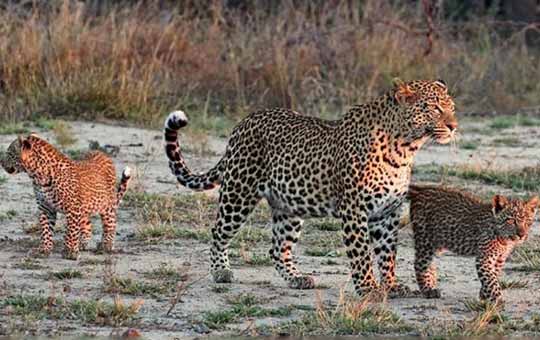Rajasthan, with its blend of rugged Aravalli hills, scrubland, and ancient rocky outcrops, offers some of the best and most unique places in India for spotting the elusive Indian Leopard (Panthera pardus). The state has become a major hub for leopard conservation and tourism, moving beyond its traditional focus on the Royal Bengal Tiger.
Here are the best places to see leopards in Rajasthan, known for their high density and frequent sightings:
1. Jawai Bandh and Bera (Pali District)
Often dubbed the “Leopard Capital of India,” the region around the Jawai Dam and the village of Bera is arguably the premier destination. This area is unique for two main reasons:
- Unique Habitat: Leopards here primarily inhabit the granite hills, dwelling in the natural caves and rocky shelters formed by volcanic activity millions of years ago, making sightings easier as they often bask on the rocks.
- Human Coexistence: The leopards share the landscape peacefully with the local Rabari community shepherds, a rare and fascinating example of human-wildlife coexistence, which contributes to their relatively fearless nature towards safari vehicles.
Safaris are typically conducted in open jeeps, providing a good chance of a close encounter with these majestic big cats.
2. Jhalana Leopard Safari Park (Jaipur)
Located right on the outskirts of the state capital, Jaipur, Jhalana is a compact, urban wilderness and holds the distinction of being India’s first dedicated leopard reserve.
- High Density: Despite its small size, Jhalana boasts an extremely high density of leopards, with no tigers or lions to compete with, leading to very high sighting probabilities.
- Accessibility: Its proximity to Jaipur International Airport and the city center makes it one of the most accessible and time-efficient wildlife experiences in the country.
3. Amagarh Leopard Reserve (Jaipur)
Situated near the historical Galta Ji (Monkey Temple) on the eastern side of Jaipur, Amagarh is Rajasthan’s second dedicated leopard reserve, following Jhalana’s success.
- Newer Reserve: Officially operational for safaris since 2022, it is rapidly gaining popularity.
- Aravalli Terrain: The reserve’s landscape of Aravalli hills and rocky sections provides an excellent habitat for its growing leopard population.
4. Kumbhalgarh Wildlife Sanctuary (Rajsamand District)
Encompassing the magnificent Kumbhalgarh Fort, this sprawling sanctuary is a beautiful mix of dense forest, rugged terrain, and deep ravines.
- Biodiversity: While leopards are the primary draw, the sanctuary is also a key habitat for the Indian Wolf, Sloth Bear, and various deer species.
- Historical Backdrop: The 36-km-long wall of the Kumbhalgarh Fort provides a unique, historic backdrop to the natural wilderness, adding another layer to the safari experience.
5. Sariska Tiger Reserve (Alwar District)
Though predominantly a Tiger Reserve, Sariska has a healthy and thriving population of leopards, often sighted in the hilly and rocky sections of the park, making a safari here a potential big-cat double-header.
For the highest chance of a dedicated leopard sighting experience, Jawai-Bera and Jhalana are your best bets, offering consistent sightings year-round. The best time to visit for clear views and comfortable weather is typically from October to March.
